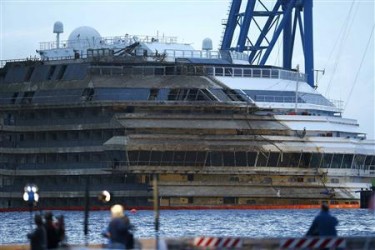GIGLIO, Italy (Reuters) – The Costa Concordia liner was pulled upright off the island of Giglio today, in one of the world’s most complex and expensive salvage operations which the prime minister said had boosted Italy’s battered national pride.

REUTERS/Tony Gentile
The Concordia, a 290-metre-long (950-foot-long) liner carrying more than 4,000 passengers and crew, capsized and sank, killing 32 people on January 13, 2012, after it came too close to shore and jagged rocks tore a hole in its side.
In a 19-hour operation which ended at 4 am (10 p.m. ET), the 114,500-ton ship was pulled from its side to an upright position by a series of huge jacks and cables and lowered onto underwater platforms drilled into the rocky sea bed.
Prime Minister Enrico Letta congratulated Franco Gabrielli, the official in overall charge, by telephone. “I told him everyone working there is a source of great pride to Italy,” he said in a tweet.
Nick Sloane, the South African engineer who has led the operation for the US-Italian contractors consortium Titan-Micoperi, was greeted by local residents as he came ashore.
“I think the whole team is proud of what they achieved. A lot of people said it couldn’t be done,” he told reporters at the quayside before heading off to celebrate with jubilant colleagues. “I feel good, it’s time for a beer.”
When daylight broke, the marks of the giant liner’s 20 months on the rocks were clearly visible. Brown mud and scum stains covered one half of the gashed and crumpled hull which had been crushed under its own weight.
The vessel, with two thirds of its body now resting in 30 meters of water, will remain in place for some months while it is stabilized and refloated before being towed away to be broken up for scrap.
CAPTAIN ON TRIAL
In contrast to the accident, a catalogue of mishap and misjudgement over which Concordia’s captain Francesco Schettino is facing multiple criminal charges including manslaughter, the salvage was a tightly coordinated engineering feat.
A multi-national team of 500 salvage technicians and divers has been on Giglio for most of the past year, stabilizing the wreck and preparing for the lifting operation, which had never been tried on so large a vessel in such challenging conditions.
Schettino, accused of causing the accident and abandoning ship on the night of the disaster, was widely seen as a symbol of all that was wrong with Italy, unsure of itself after years of recession and political scandal.
Gabrielli said the success of an operation in which Italian engineering competence was decisive should be a boost to national confidence. “Today our country can resume the position and role which it needs to have,” he told reporters.
After a three hour delay due to an overnight storm on Monday, the so-called “parbuckling” operation, in which the hulk was painstakingly rotated upright, took much longer than the 10-12 hours estimated. Engineers said it had gone smoothly.
“It was a perfect operation, I would say,” said Franco Porcellacchia, leader of Costa Cruise’s technical team.
The Concordia salvage is expected to be the most expensive maritime wreck recovery ever, with costs that exceed 600 million euros ($801.15 million) and account for more than half of an overall insurance loss of more than $1.1 billion.
In a painstaking day of work on Monday, a series of massive jacks pulled the Concordia up inch by inch until it was raised high enough for water tanks welded to one side to start to pull it down into place by the force of gravity.
Six platforms, drilled into the rock and 16,000 tonnes of grouting piled up to create an artificial sea bed held the ship in place once it was upright.
Oil booms surround the vessel to intercept waste water and oil trapped in the ship, but officials said there appeared to have been no significant environmental damage.
The work will not be complete until the vessel is towed away from the island, probably by next spring but Sloane said any operational challenges could be met.
“The weather is the main thing, if you have good weather and you have a good plan, then you just have to follow the plan.”

